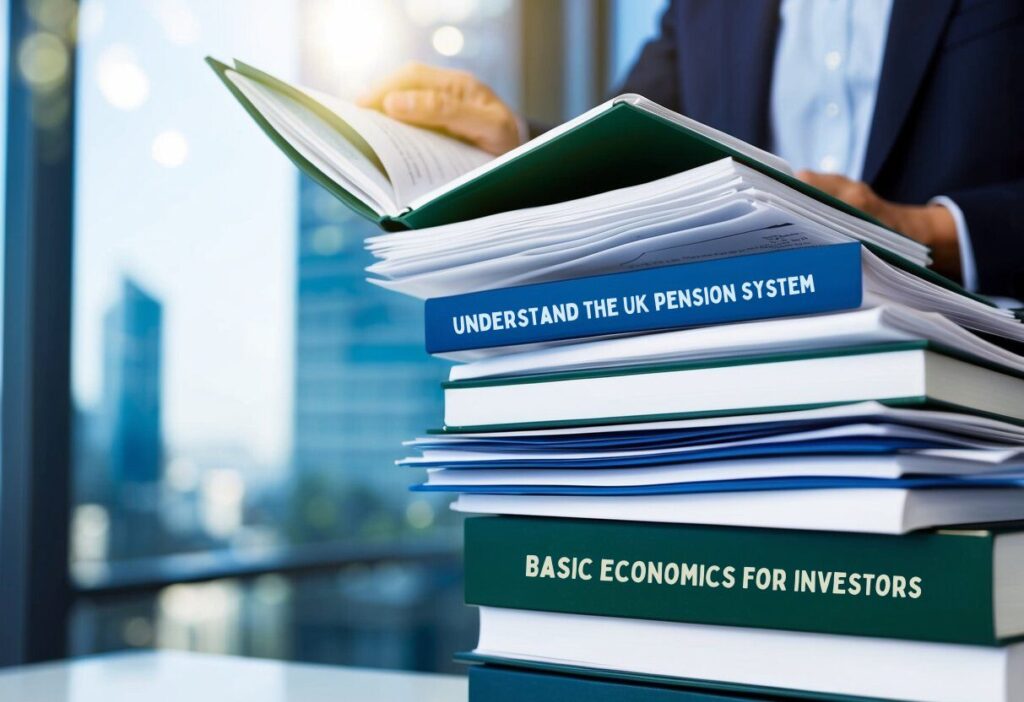Navigating the UK pension system can feel overwhelming, but it’s essential for planning a secure future. The UK pension system offers a mix of state, workplace, and personal pensions to build a stable retirement income. People can start contributing early to reap the benefits later in life.

Eligibility varies for each type of pension, and understanding contributions is crucial. Knowing when and how to access your pension can make a significant difference in retirement. Different investment strategies can also impact pension value over time.
Effectively managing and accessing pensions can provide financial independence in retirement. Making informed decisions ensures you get the most out of your lifetime savings.
Key Takeaways
- The UK combines state, workplace, and personal pensions.
- Eligibility and contributions determine pension benefits.
- Managing investments is crucial for pension growth.
Overview of the UK Pension System

The UK pension system is comprised of various schemes to provide financial support during retirement. This system includes state pensions run by the government and private or workplace pensions managed by employers or individuals. Understanding these options assists individuals in planning for a secure retirement.
Types of Pensions Available
Pensions in the UK can be categorised into three primary types: State Pensions, Workplace Pensions, and Personal Pensions. Each type serves different needs and comes with its own benefits and rules.
- State Pension: Basic income provided by the government.
- Workplace Pension: Typically offered by employers as part of a job.
- Personal Pension: Voluntary savings set up through a private provider.
Each pension type offers different ways to accrue savings for retirement.
The State Pension Scheme
The State Pension is a regular payment from the government that one may claim upon reaching State Pension age. It is based on National Insurance contributions made during a person’s working life. As of the latest update, qualifying requires at least 10 years of contributions.
Recipients may earn more with up to 35 years of contributions.
The amount received is reviewed annually to maintain its value in line with inflation. Anyone can check their State Pension forecast online to see how much they might get in the future. This ensures transparency and helps individuals plan their retirement finances efficiently.
Private and Workplace Pensions
Private pensions are personal savings plans not tied to State Pension benefits. They offer flexibility, as individuals can choose their contribution rate. Private pensions are often associated with long-term investments, possibly increasing retirement funds.
Workplace pensions are arranged by employers. Employers are required by law to enrol eligible staff automatically. They deduct contributions from wages while adding their contribution, effectively boosting retirement savings.
There are different types of workplace pensions, such as defined benefit or defined contribution schemes. These pensions are invaluable for supplementing state pensions. Private and workplace pensions ensure retirees have a more comfortable income, tailored to their specific needs and circumstances.
Eligibility and Contributions

The UK pension system includes the State Pension and workplace pensions. Eligibility depends on National Insurance contributions. Contributions vary by employment status and pension type.
Qualifying for the State Pension
To qualify for the State Pension, individuals need a record of National Insurance (NI) contributions. Typically, at least 10 qualifying years are required. These years do not have to be consecutive. A full State Pension requires around 35 qualifying years.
NI contributions can be made through employment, self-employment, or voluntary contributions. Those without enough qualifying years might receive a reduced pension. Contributions stop upon reaching State Pension age, but voluntary contributions may be made for gaps. This ensures a stable pension income upon retirement.
Workplace Pension Enrolment
Workplace pensions are part of automatic enrolment schemes. Employees are eligible if they are aged between 22 and State Pension age, and earn more than £10,000 a year. Employers must enrol these employees, and both parties contribute to the pension.
Employers choose a suitable pension scheme, often arranging payroll deductions. Employees can opt out, although staying in is usually advised. Rising contribution levels increase pension savings, providing financial security upon retirement.
Contribution Levels and Limits
Contribution levels vary across different pension schemes. For workplace pensions, the current minimum contribution is 8% of qualifying earnings. This is typically split as 5% from the employee and 3% from the employer. Additional voluntary contributions can boost pension savings.
Self-employed individuals must arrange their own pensions, often with personal or stakeholder pensions. Contribution limits depend on pension type and income. The annual limit is set at £60,000 for tax-relieved contributions, though unused relief can be carried over from the past three years.
Understanding these details ensures individuals maximise their retirement savings while staying within legal and tax guidelines.
Accessing Your Pension

Accessing your pension in the UK involves knowing the age when you can start, the ways to take out your money, and how taxes affect your withdrawals. Being informed about these aspects can help you make good decisions.
Pension Commencement Age
In the UK, the usual age to access a pension is currently 55, but changes are coming. From April 2028, this will rise to 57. It’s important to plan ahead as many people aim to retire around this time.
Different pensions, like State and workplace pensions, may have specific rules. The State Pension age is already set between 66 and 68, depending on one’s birth date. Knowing these ages is crucial for retirement planning.
Early access is possible for those with medical conditions, but this often requires a strong case. Carefully consider your age and health before deciding. Being mindful of these details can ensure your pension lasts throughout retirement.
Taking Pension Benefits
Options for taking pension benefits include withdrawing lump sums or setting up a regular income. One popular choice is “drawdown”, letting funds remain invested while taking money out gradually. This provides flexibility but carries investment risks.
Another way is to buy an annuity, providing a guaranteed income for life or a set period. Annuities are secure but may offer less flexibility compared to other methods. Some prefer a combination of a small annuity with regular withdrawals.
Review the terms of each pension scheme, as rules may vary. Each option has benefits depending on a person’s lifestyle and financial needs. Consulting a financial adviser can also help identify the right choice.
Tax Implications on Withdrawals
Understanding tax implications is key when drawing from a pension. Initially, a 25% tax-free lump sum is often available. The remaining withdrawals are subject to income tax, meaning planning withdrawals is important to manage tax bills.
Considering personal tax bands is vital, especially if other income exists. Large withdrawals may push someone into a higher tax band, affecting their overall income.
Regularly reviewing pension withdrawals and tax status can be beneficial. This approach helps avoid unexpected tax charges and ensure funds last longer. Keeping track of tax rules and limits can protect financial interests in retirement.
Managing Pension Investments

People have many choices when investing pensions in the UK. It’s important to consider different investment options, understand the balance between risks and returns, and know how to switch providers if needed.
Investment Choices
Pension savers can select from various investment options. Stocks and shares are popular as they often give higher returns. Bonds are safer but generally yield lower profits. Property investments can offer good growth but might be less liquid.
Additionally, cash funds provide stability with minimal risk but may not keep up with inflation over time. Savers can also opt for ethical investments if they want their money to align with personal values. These choices depend on individual risk tolerance and financial goals.
Risks and Returns
Investing always involves some risk. Stock markets can be unpredictable, and values may rise or fall. Larger risks can potentially lead to higher returns, but they also pose greater chances of loss.
Bonds and cash investments tend to be safer, but their returns can be lower. Diversification can help spread risk across different asset classes. This means not putting all funds into one type of investment. Understanding how much risk one is comfortable with can guide decisions.
Changing Providers
Sometimes, savers decide to change who manages their pension. This might be because of better options, lower fees, or unsatisfactory service. Changing providers is possible, but it’s important to consider transfer fees and other costs.
Transfer processes may take time, so planning is essential. Reviewing terms and conditions before making a switch ensures no benefits are lost. Comparing different providers can reveal better investment opportunities and improve long-term outcomes. Keeping track of financial performance aids this decision significantly.